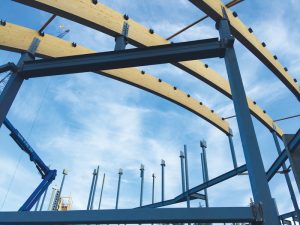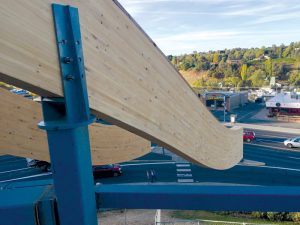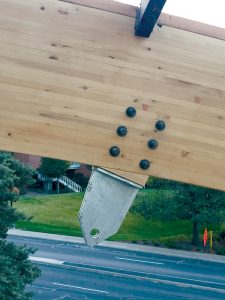Elson S. Floyd Cultural Center at Washington State University
When Washington State University (WSU) set out to build the new Elson S. Floyd Cultural Center on their campus in Pullman, they had a number of goals: bring the University’s diverse cultural organizations together under one roof, incorporate natural building materials native to the area into the structure, and build something unique yet iconic that would serve as a marquee building. The resulting 16,000-square-foot structure, created through a design-build collaboration with PCS Structural Solutions, GGLO Design, and Absher Construction, is distinguished by an undulating wood roof structure intended to emulate the rolling prairies of the Palouse, native to the local Nez Perce Tribe.
There are just a handful of right angles to be found in this unique building, and not a single connection in the roof structure is repeated. In other words, it was a structural engineer’s dream.
Engineers understand the challenge of creating simplicity out of complexity when everything is unique. With this project, a design/build approach and a wood structure held the keys to success. In fact, the team determined that the design/build budget could not have been met if this particular roof structure had been built using a material other than wood.
Making a Statement
Most engineers agree that the best part of a design/build project is the initial stage, when ideas are big and concepts are still being developed. This project was no exception. Five teams submitted designs; each had three opportunities to present their concepts to WSU and the bridging team.
Initially, architects at GGLO conducted pedestrian footpath studies to determine access and building alignment; they also did daylight studies since the structure needed to protect artwork inside. However, the team was in last place after the first meeting; their second design also did not meet client goals. So, with the clock ticking, the architects started over and developed the final design on the proverbial napkin, leaving engineers at PCS Structural Solutions just a week to figure out how to make it all work. They did, WSU administrators were sold, and the design/build team of PCS/GGLO/Absher was hired.
The resulting design went from a building that would make a statement architecturally to a building that makes a statement both architecturally and structurally.
Design/Build
There are many challenges when taking a design/build approach but, sometimes, design/build is the only way to approach a complex project like this. Although a design/build format is common for larger contracts, this was just a $16 million project, so stakes were high.
WSU wanted to use native materials and the University has a deep appreciation for wood products and technologies. They also liked the curved roof concept, so the resulting structure controlled much of the design. However, the team needed to balance the project’s complexity against the financial constraints of their design/build requirements, so it was critically important to work together. Architects at GGLO were looking for a statement, the engineers were looking for structure, and the contractor was looking for speed and ease of construction. Lead time was also critical; there was an early bid package for foundations and structure, which put additional pressure on the consultants to provide product in a timely manner. All challenges led the team to design a wood roof structure constructed with glulam beams.

8¾- x 36-inch glulam roof beams were erected onto a steel infrastructure; steel columns were tilted toward the center of the building at the large spans to accommodate lateral spreading.
Wood provided both form and function. Glulam beams met complicated loading requirements and the sinuous structure, constructed with glulam girder beams left exposed to the interior, reflected elements of Nez Perce basket weaving traditions.
Creating Simplicity from Complexity
Building complexity required close collaboration and accurate 3D drawings, so everyone on the team used Revit. The contractor also used a total station to increase the accuracy of the site measurements; the design was so fluid that there was no common roof elevation.

Double curvature glulam beams were seated onto the steel column pedestals using round capital plates to showcase the structural steel column-to-glulam beam connections.
The undulating roof design required a wide variety of glulam types – single curvature beams, reverse double curvature beams, out-of-plane curvature beams, as well as turned and tapered glulam columns. The team knew they needed a roof structure that could replicate itself; too much deviation would lose on both cost and constructability. Because spans and cantilevers varied for each beam, it was difficult to provide a common beam size that would work for all conditions and meet budget. Shipping was also a consideration; the beams were manufactured 600 miles away and trucked from Vancouver, Washington, so maximum beam length was 65 feet.

This single curvature beam was connected to a turned double-tapered glulam column using a kerfed connection to hide the connector’s side plates from view.
The team decided to make all the beams consistent with the same radius, 86 feet 3 inches. What changed, though, was the top condition of the beams. Beveled plates added to the top of each glulam beam adapt to the ever-changing roof slope.
Allow the Building to Breathe
Structural engineers at PCS were challenged to account for the flexible building design. To fully understand how the building would deflect and how the beams would behave against adjacent members, they had to divorce everything they knew about typical building construction and entirely rethink the construction process.
Eastern Washington has a ground snow load of 30 psf so, depending on the spans and cantilevers, adjacent beams had drastically different deflections due to the irregular shape of the floor plan. Typically, arched beams are restrained by buttress action or through the use of steel tie rods. However, adding these elements to resist the 30,000 pounds of thrust at each beamline would have compromised the building’s aesthetics. With no physical buttress, the building would behave like a breathing mechanism as live loads were applied and removed. Wall finishes and ceilings were designed with appropriate gaps that would allow the building to expand and contract as the beams deflect and force the walls to move out of plane.
PCS determined that the only way to control lateral deflection and accommodate the differential deflections between adjacent members was to engineer the glulam beams based on stiffness rather than strength alone. They used STAAD, the 3D structural analysis and design software, to help determine the interaction of beam deflection with adjacent beams and to calculate the various load cases of wind and snow drift. To minimize lateral spreading and differential deflections, they specified 8¾- x 36-inch glulam beams. They intentionally tilted the steel columns 1 inch toward the center of the building at the large spans to accommodate for the lateral spreading, so that the columns would be plumb when the building’s dead load was applied. The contractor monitored column displacements during construction, and particularly during snow events, to ensure modeling accuracies.
The Elson S. Floyd Cultural Center has a total of 62 curved girder glulam beams which were constructed with Port Orford cedar, a naturally decay-resistant species. Except at the steeper roof sections (which required tighter spacing), the beams were spaced at 8-foot centers. Glulam fascia beams, 3 1⁄8 x 18 inches, were curved out of plane to define building shape and act as the diaphragm chord. The remainder of the roof was constructed with canted and sloped 4×8 beams spaced 48 inches on-center, covered by two layers of plywood sheathing laid at 45-degree angles to each other.
Altogether, the project contains 125,000 board feet of glulam, which was treated with a UV coating to protect the wood from Eastern Washington’s harsh, arid sun. Staff at APA – The Engineered Wood Association (APA) provided PCS engineers with recommendations regarding flashing details to protect the glulam beam tails, which were left exposed to the exterior.
Connection Complexity
Every angle and connection was unique, requiring the use of simple and repeatable connectors to meet the design/build budget. Since the roof structure and many connections were left exposed, the solutions needed to be efficient yet elegant to complement the architecture. Many of the beam-to-column connections are kerfed to hide the connectors’ side plates from view. Custom tapered WTs and round capital plates are used on top of the columns to showcase the structural steel column-to-glulam beam connections.
Connections between the concrete shear wall and the glulam bearing were complicated, due to the varying geometries. Steel plates embedded into the walls made it easier for the contractor to set beam seats at the correct elevation, skew, and slope. To speed erection time, engineers designed steel brackets with bent side angle plates. The connection had an adjustable swivel bearing seat that readily accepted the various beam bearing slopes. Once the beam was set at the correct elevation, the bracket was welded to the embedded steel. This detail was so successful that the contractor did not have a single Request for Information (RFI) related to a misaligned glulam beam connection.
Details for the steel connecting the 4×8 purlins to the glulam beams were equally complex. Due to the biaxial bending on the beams, there were no off-the-shelf products available to suit the canted, sloped, and skewed conditions that were required at each unique connection. To speed erection, fabricated 16 gauge bent U-shaped plates with pre-drilled holes were preinstalled on the ground before the glulam beams were lifted into place.
Design Goals, Structural Solutions
With a design/build project, money and budget are essential; the cheapest solution does not always originate from lower material costs. In this situation, the use of custom glulam beams were slightly more expensive. However, repeatable yet adjustable connections sped construction and reduced complexity, saving headaches and money.
At the same time, the unique wood roof structure allowed the design/build team to meet WSU’s aesthetic and cultural goals while accommodating the complex structural challenges of the loading on this undulating roof structure. Even though every angle and every connection was unique, the team was able to create simplicity from complexity.▪
